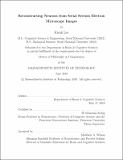Reconstructing neurons from serial section electron microscopy images
Author(s)
Lee, Kisuk, Ph. D. Massachusetts Institute of Technology.
Download1264708701-MIT.pdf (36.38Mb)
Other Contributors
Massachusetts Institute of Technology. Department of Brain and Cognitive Sciences.
Terms of use
Metadata
Show full item recordAbstract
Neuronal connectivity can be reconstructed from a 3D electron microscopy (EM) image of a brain volume. A challenging and important subproblem is the segmentation of the image into neurons. For the past decade, convolutional networks have been used for 3D reconstruction of neurons from EM brain images. In this thesis, we develop a set of deep learning algorithms based on convolutional nets for automated reconstruction of neurons, with particular focus on highly anisotropic images of brain tissue acquired by serial section EM (ssEM). In the first part of the thesis, we propose a recursively trained hybrid 2D-3D convolutional net architecture, and demonstrate the feasibility of exploiting 3D context to further improve boundary detection accuracy despite the high anisotropy of ssEM images. In the following parts, we propose two techniques for training convolutional nets that can substantially improve boundary detection accuracy. First, we introduce novel forms of training data augmentation based on simulation of known types of image defects such as misalignments, missing sections, and out-of-focus sections. Second, we add the auxiliary task of predicting affinities between nonneighboring voxels, reflecting the structured nature of neuronal boundary detection. We demonstrate the effectiveness of the proposed techniques on large-scale ssEM images acquired from the mouse primary visual cortex. Lastly, we take a radical departure from simple boundary detection by exploring an alternative approach to object-centered representation, that is, learning dense voxel embeddings via deep metric learning. Convolutional nets are trained to generate dense voxel embeddings by assigning similar vectors to voxels within the same objects and well-separated vectors to voxels from different objects. Our proposed method achieves state-of-the-art accuracy with substantial improvements on very thin objects.
Description
This electronic version was submitted by the student author. The certified thesis is available in the Institute Archives and Special Collections. Thesis: Ph. D. in Computation, Massachusetts Institute of Technology, Department of Brain and Cognitive Sciences, June, 2019 Cataloged from student-submitted PDF version of thesis. Includes bibliographical references (pages 155-167).
Date issued
2019Department
Massachusetts Institute of Technology. Department of Brain and Cognitive SciencesPublisher
Massachusetts Institute of Technology
Keywords
Brain and Cognitive Sciences.